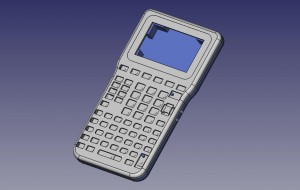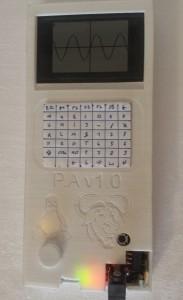I use the calculator function on my smart phone to figure out bill payments or anticipate paycheck amounts, mainly. But there was a time, years ago, when I did use a calculator for math class and standardized exams. It was essential to have one for a period in high school, and for my friends who pursued mathematics in college, they could be counted on to be carrying one in their backpacks. What use would a calculator with a 3D printed case and free, open source software have in the era of the smart phone? That’s a good question to ask since the LibreCalc is a new open source, programmable calculator with a downloadable design available now.
The LibreCalc is really an “embedded computer”, and calculators are frequently the gateway to code and programming –thus proving the inherent educational value of such a device. But I am sure you can start imagining other reasons to have a computer instead of a mere calculator. Yes, that’s tight: during test time. And yes again, that would be called cheating–but who’s keeping track? The LibreCalc exists and anyone who continues to be fascinated by the various frontiers traversed by modern technological innovation will appreciate the device for what it’s worth (especially if that includes a higher score on an important exam!)
The motivation behind this idea is described on the LibreCalc site:
“We aim to make a scientific calculator, fully usable, with good ergonomics, which will be fully free software and open hardware. This calculator will need to have all the capacities of calculators that are currently on the market. In particular it will have to include [a] computer algebra system. Calculators are sometimes the first tool[s] young people use to learn programming. We don’t want that their curiosity [to] be discouraged because manufacturers close their products.”
 This calculator is the brainchild of two young Frenchmen — Pierre Parent and Ael Gain — who explain that they want to bring a computer algebra system (CAS) in a much lower range of prices to classrooms. They even include a section geared toward educators and classrooms on their website, asking for teacher feedback regarding what current calculators are missing. They are determined to make the LibreCalc as accessible as possible–having released all of the hardware designs so that anyone can build this calculator. The LibreCalc is based on the user-friendly and accessible imx233 processor, and all of its designs are available — including the circuit board and CAD files for the case. The calculator’s software is free and it runs Linux. For anyone who has grown used to using Texas Instruments calculators, you can also access a simulator environment to ease your transition to this new calculator.
This calculator is the brainchild of two young Frenchmen — Pierre Parent and Ael Gain — who explain that they want to bring a computer algebra system (CAS) in a much lower range of prices to classrooms. They even include a section geared toward educators and classrooms on their website, asking for teacher feedback regarding what current calculators are missing. They are determined to make the LibreCalc as accessible as possible–having released all of the hardware designs so that anyone can build this calculator. The LibreCalc is based on the user-friendly and accessible imx233 processor, and all of its designs are available — including the circuit board and CAD files for the case. The calculator’s software is free and it runs Linux. For anyone who has grown used to using Texas Instruments calculators, you can also access a simulator environment to ease your transition to this new calculator.
The project is still in its prototype phase, and Parent and Gain have blogged their progress, beginning last February, 2014, with the most recent entry about their second prototype completion entered on December 5, 2014. The recent prototype boasts features including: nicer 3D printed casing and keyboard; 128 MB of Ram; “complete autonomy” (no external cable, computer, or power supply needed for booting–with boot to calculation interface time currently under 8 seconds); and software improvements (including Menu, Python, and Computer Algebra).
Regarding the 3D printed case portion of the project, the blog features a brief entry about the  second case modeling, describing how Blender would be the obvious choice to fulfill their desire to use FreeCAD, but its animation, light, and textures are not proving so useful. On July 15, 2014 a blog entry describes that the design for the first case was done in FreeCAD and 3D printed. A comparison of the first prototype (see in photo to right) and the second prototype (see top photo) shows that the case design has changed quite a bit since the beginning of the project. The layout for the keyboard is completely different.
second case modeling, describing how Blender would be the obvious choice to fulfill their desire to use FreeCAD, but its animation, light, and textures are not proving so useful. On July 15, 2014 a blog entry describes that the design for the first case was done in FreeCAD and 3D printed. A comparison of the first prototype (see in photo to right) and the second prototype (see top photo) shows that the case design has changed quite a bit since the beginning of the project. The layout for the keyboard is completely different.
You can go ahead and see what is available now for downloading here, as the LibreCalc design continues to become refined while responding to user input in a openly public design process. (Also see video that shows the LibrCalc’s second prototype running below.)
Subscribe to Our Email Newsletter
Stay up-to-date on all the latest news from the 3D printing industry and receive information and offers from third party vendors.
You May Also Like
Gorilla Sports GE’s First 3D Printed Titanium Cast
How do you help a gorilla with a broken arm? Sounds like the start of a bad joke a zookeeper might tell, but it’s an actual dilemma recently faced by...
Nylon 3D Printed Parts Made More Functional with Coatings & Colors
Parts 3D printed from polyamide (PA, Nylon) 12 using powder bed fusion (PBF) are a mainstay in the additive manufacturing (AM) industry. While post-finishing processes have improved the porosity of...
$25M to Back Sintavia’s Largest Expansion of Metal 3D Printing Capacity Since 2019
Sintavia, the digital manufacturing company specializing in mission-critical parts for strategic sectors, announced a $25 million investment to increase its production capacity, the largest expansion to its operations since 2019....
Velo3D Initiates Public Offering in a Bid to Strengthen Financial Foundations and Drive Future Growth
Velo3D (NYSE: VLD) has been among a number of publicly traded 3D printing firms that have attempted to weather the current macroeconomic climate. After posting a challenging financial report for 2023,...

































